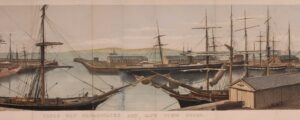LEPORELLO OF THE VICTORIA AND ALFRED WATERFRONT, CAPE TOWN
“Table Bay Breakwater and Cape Town Docks”, lithograph made in 1874 by Messrs. Hanhart of London, after a photograph taken by Mr. Moore of Cape Town, for the Table Bay Harbour Board. Coloured by a later hand. Size: 16 x 130 cm.
The Table Bay Breakwater was constructed between 1872 and 1914 to provide protection for ships entering Table Bay. The Cape Town Docks, also known as Victoria & Alfred Waterfront was named after Queen Victoria and Prince Alfred to commemorate their visit to the city in the late 1800s.
The view shows the entrance and inner basin, with the mail packet boats lying at their usual berths, the Union Company’s steamer “Nyanza” at the East Quay, and Donald Currie & Co’s steam-ship “Windsor Castle”, with the coasting steamer Florence alongside, at the North Quay. The excavations for the Graving Dock in progress, are noticeable at the left corner of the picture. (Cape Town’s Graving Dock would become one of the largest dry docks in the southern hemisphere.) On the right there’s the Devil’s Peek and Table Mountain.
Cape Town in those days was a rapidly growing port city and the capital of the Cape Colony, then a British colony. During this period, Cape Town was undergoing significant expansion and modernization, with new infrastructure being built to support the city’s growing population and economy. The port was a major hub for trade, connecting southern Africa to the rest of the world, and the city was home to a diverse population of Europeans, enslaved Africans, and indigenous peoples. The city was seen as a center of culture, innovation, and opportunity, attracting immigrants and entrepreneurs from around the world.
Price: Euro 575,-











